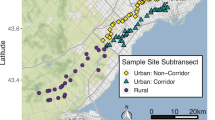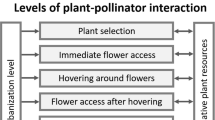Abstract
The world is increasingly urban, and urbanization alters the abundance and distribution of resources important to mutualist pollinators. Pollinators require distinct and diverse resources throughout their life cycle, including larval habitat and adult food resources. However, the relationship among urbanization, pollinator resource distribution, pollinator abundance, and pollination service provision are uncertain. Here, we test whether the presence of rat carrion facilitates pollination service to a non-native plant, Ammi majus L. (Apiaceae), by bolstering the pollinator community across an urban gradient. We show that carrion increased pollinator abundance and service provision to focal plants, especially in densely urban landscapes. Specifically, a paired experimental design revealed that in the presence of rat carrion, pollinator abundance increased by more than two-fold and plants received 11.2% greater pollination service across landscapes. Those plants situated in highly urban contexts received the greatest benefits from carrion with the largest abundance of pollinators and highest proportion of viable seed set. We demonstrate how human development facilitates the reproduction of a non-native plant by altering the pollinator community and pollination service provided across an urban gradient. Our findings have both basic and applied implications. First, we show that mutualistic species with complex life histories can provide conduits between various levels of ecosystem processes. Second, we suggest that the removal or reduction of larval habitat may serve as a tool in the management of non-native Apiaceae plants in the upper Midwest.



Similar content being viewed by others
References
Barton PS, Evans MJ, Foster CN, Pechal JL, Bump JK, Quaggiotto MM, Benbow ME (2019) Towards quantifying carrion biomass in ecosystems. Trends Ecol Evol 34:950–961. https://doi.org/10.1016/j.tree.2019.06.001
Benbow ME, Tomberlin JK, Tarone AM (2015) Carrion ecology, evolution, and their applications. CRC Press, Boca Raton
Benbow ME, Barton PS, Ulyshen MD, Beasley JC, DeVault TL, Strickland MS, Tomberlin JT, Jordan HR, Pechal JL (2019) Necrobiome framework for bridging decomposition ecology of autotrophically and heterotrophically derived organic matter. Ecol Monogr 89:e01331
Champely S (2018). PairedData: paired data analysis. R package version 1.1. 1
Clement SL, Hellier BC, Elberson LR, Staska RT, Evans MA (2007) Flies (Diptera: Muscidae: Calliphoridae) are efficient pollinators of Allium ampeloprasum L. (Alliaceae) in field cages. J Econ Entomol 100:131–135
Cussans J, Goulson D, Sanderson R, Goffe L, Darvill B, Osborne JL (2010) Two bee-pollinated plant species show higher seed production when grown in gardens compared to arable farmland. PLoS One 5:e11753
de Moretti TC, Thyssen PJ, Solis DR (2006) Breeding of the scuttle fly Megaselia scalaris in fish carcass and implications for the use in forensic entomology (Diptera: Phoridae). Entomol Gen 31(4):349
Erickson WP, Johnson GD, David Jr P (2005) A summary and comparison of bird mortality from anthropogenic causes with an emphasis on collisions. In: Ralph CJ, Rich TD (eds) 2005. Bird Conservation Implementation and Integration in the Americas: Proceedings of the Third International Partners in Flight Conference. 2002 March 20–24; Asilomar, California, Volume 2 Gen. Tech. Rep. PSW-GTR-191. Albany, CA: US Dept. of Agriculture, Forest Service, Pacific Southwest Research Station 191: 1029–1042
Estes JA, Tinker MT, Williams TM, Doak DF (1998) Killer whale predation on sea otters linking oceanic and nearshore ecosystems. Science 282:473–476
Fischer OA (2000) Blowflies of the genera Calliphora, Lucilia and Protophormia (Diptera, Calliphoridae) in south-Moravian urban and rural areas with respect to Lucilia bufonivora Moniez, 1876. Acto Vet Brno 69:225–231
Forman RT, Alexander LE (1998) Roads and their major ecological effects. Annu Rev Ecol Evol Syst 29:207–231
Free JB (1993) Insect pollination of crops (No. Ed. 2). Academic Press
Herrera CM (1987) Components of pollinator “quality”: comparative analysis of a diverse insect assemblage. Oikos 50:79–90
Hill JE, DeVault TL, Belant JL (2020) Research note: a 50-year increase in vehicle mortality of north American mammals. Landsc Urban Plan 197:103746
Howlett BG (2012) Hybrid carrot seed crop pollination by the fly Calliphora vicina (Diptera: Calliphoridae). J Appl Entomol 136:421–430
Hwang C, Turner BD (2005) Spatial and temporal variability of necrophagous Diptera from urban to rural areas. Med Vet Entomol 19:379–391
Ibisch PL, Hoffmann MT, Kreft S, Pe’er G, Kati V, Biber-Freudenberger L, Selva N et al (2016) A global map of roadless areas and their conservation status. Science 354:1423–1427
Inouye DW, Larson BM, Ssymank A, Kevan PG (2015) Flies and flowers III: ecology of foraging and pollination. J Pollinat Ecol 16:115–133
Kalamazoo River Watershed Council (KRWC) (2011) Kalamazoo River Watershed Management Plan. Prepared for the Michigan Nonpoint Source Program (Michigan Department of Environmental Quality and the United States Environmental Protection Agency. www.kalamazooriver.org//images/stories//krwmp_final_att_march_2011.Pdf
Kearns CA, Inouye DW (1993) Techniques for pollination biologists. University Press of Colorado, Boulder
Kearns CA, Inouye DW (1994) Fly pollination of Linum lewisii (Linaceae). Am J Bot 81:1091–1095
Kline RB (2011) Principles and practice of structural equation modeling, Third edn. Guilford Press, New York
Knight TM, McCoy MW, Chase JM, McCoy KA, Holt RD (2005) Trophic cascades across ecosystems. Nature 437:880–883
Lamborn E, Ollerton J (2000) Experimental assessment of the functional morphology of inflorescences of Daucus carota (Apiaceae): testing the ‘fly catcher effect’. Funct Ecol 14:445–454
Larson BMH, Kevan PG, Inouye DW (2001) Flies and flowers: taxonomic diversity of anthophiles and pollinators. Can Entomol 133:439–465
Lyytimäki J, Sipilä M (2009) Hopping on one leg–the challenge of ecosystem disservices for urban green management. Urban For Urban Green 8:309–315
McAlpine JF (1981) Morphology and terminology. In: McAlpine JP et al (eds) Manual of Nearctic Diptera vol. 1 Ottawa: research branch, agriculture Canada, monograph 27
McKinney ML (2002) Urbanization, biodiversity, and conservation: the impacts of urbanization on native species are poorly studied, but educating a highly urbanized human population about these impacts can greatly improve species conservation in all ecosystems. Bioscience 52:883–890
McKinney ML (2006) Urbanization as a major cause of biotic homogenization. Biol Conserv 127:247–260
Mitchell JD, Rook A (1979) Botanical dermatology: plants and plant products injurious to the skin. Greengrass Ltd., Vancouver
Nielsen C, Ravn HP, Nentwig W, Wade M (2005) The Giant hogweed best practice manual. Guidelines for the management and control of an invasive weed in Europe. Forest and Landscape Denmark, Hoersholm
Norris KR (1965) The bionomics of blow flies. Annu Rev Entomol 10:47–68
Nuorteva P (1963) Synanthropy of blowflies (Dipt., Calliphoridae) in Finland. Ann Entomol Fennici 29:1
Pace ML, Cole JJ, Carpenter SR, Kitchell JF (1999) Trophic cascades revealed in diverse ecosystems. Trends Ecol Evol 14:483–488
Pérez-Bañón C, Petanidou T, Marcos-García MÁ (2007) Pollination in small islands by occasional visitors: the case of Daucus carota subsp. commutatus (Apiaceae) in the Columbretes archipelago, Spain. Plant Ecol 192:133–151
Proctor M, Yeo P, Lack A (1996) The natural history of pollination. Harper Collins Publishers, London
Quantum GIS (2013) Development team. qGIS 2:0
Rader R, Bartomeus I, Garibaldi LA, Garratt MP, Howlett BG, Winfree R et al (2016) Non-bee insects are important contributors to global crop pollination. PNAS 113:146–151
Rajmis S, Thiele J, Marggraf R (2016) A cost-benefit analysis of controlling giant hogweed (Heracleum mantegazzianum) in Germany using a choice experiment approach. NeoBiota 31:19–41
Richardson DM, Allsopp N, D'antonio CM, Milton SJ, Rejmánek M (2000) Plant invasions–the role of mutualisms. Biol Rev 75:65–93
Rosseel Y (2012) Lavaan: an R package for structural equation modeling and more. Version 0.5–12 (BETA). J Stat Softw 48:1–36
Schoof HF, Mail GA, Savage EP (1954) Fly production sources in urban communities. J Econ Entomol 47:245–253
Simberloff D, Von Holle B (1999) Positive interactions of nonindigenous species: invasional meltdown? Biol Invasions 1:21–32
Sinclair ARE, Mduma S, Brashares JS (2003) Patterns of predation in a diverse predator–prey system. Nature 425:288–290
Skevington JH, Dang PT (2002) Exploring the diversity of flies (Diptera). Biodiversity 3:3–27
United Nations Human Settlements Programme (UDSA) (2010) State of the world’s cities 2010/2011: bridging the urban divide. Earthscan
USDA (2015) Field guide for managing poison hemlock in the southwest. wwwfsusdagov/Internet/FSE_DOCUMENTS/stelprdb5410121pdf. Accessed 1 Nov 2019
White RE (1998) The Beetles of North America, vol 29. Houghton Mifflin Harcourt
Whitworth T (2006) Keys to the genera and species of blow flies (Diptera: Calliphoridae) of America north of. Proceedings of the Entomological Society of Washington. 108689: 725
Yang L, Jin S, Danielson P, Homer C, Gass L, Case A, Costello C, Dewitz J, Fry J, Funk M, Grannemann B, Rigge M, Xian G (2018) A new generation of the United States National Land Cover Database: requirements, research priorities, design, and implementation strategies, ISPRS. J Photogramm Remote Sens 146:108–123
Zangerl AR, Berenbaum MR (2009) Effects of florivory on floral volatile emissions and pollination success in the wild parsnip. Arthropod Plant Interact 3:181–191
Zhang W, Ricketts TH, Kremen C, Carney K, Swinton SM (2007) Ecosystem services and dis-services to agriculture. Ecol Econ 64:253–260
Acknowledgements
Special thanks to Stephanie Clark, Kathleen Knupp, and the Haddad lab for help in the lab and valuable feedback.
Author information
Authors and Affiliations
Corresponding author
Electronic supplementary material
ESM 1
(DOCX 319 kb)
Rights and permissions
About this article
Cite this article
Cusser, S., Pechal, J.L. & Haddad, N.M. Carrion increases pollination service across an urban gradient. Urban Ecosyst 24, 243–250 (2021). https://doi.org/10.1007/s11252-020-01032-z
Published:
Issue Date:
DOI: https://doi.org/10.1007/s11252-020-01032-z




